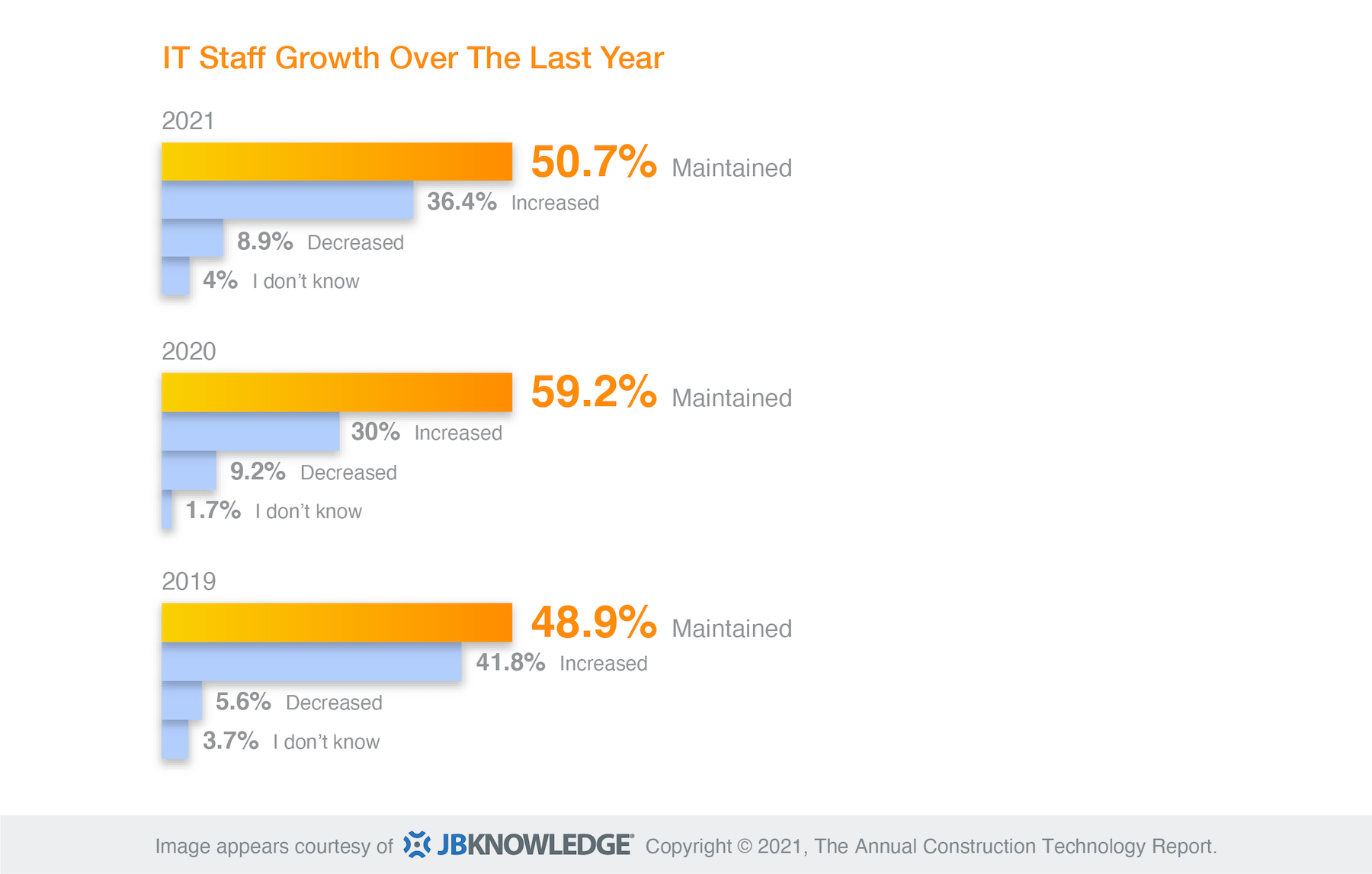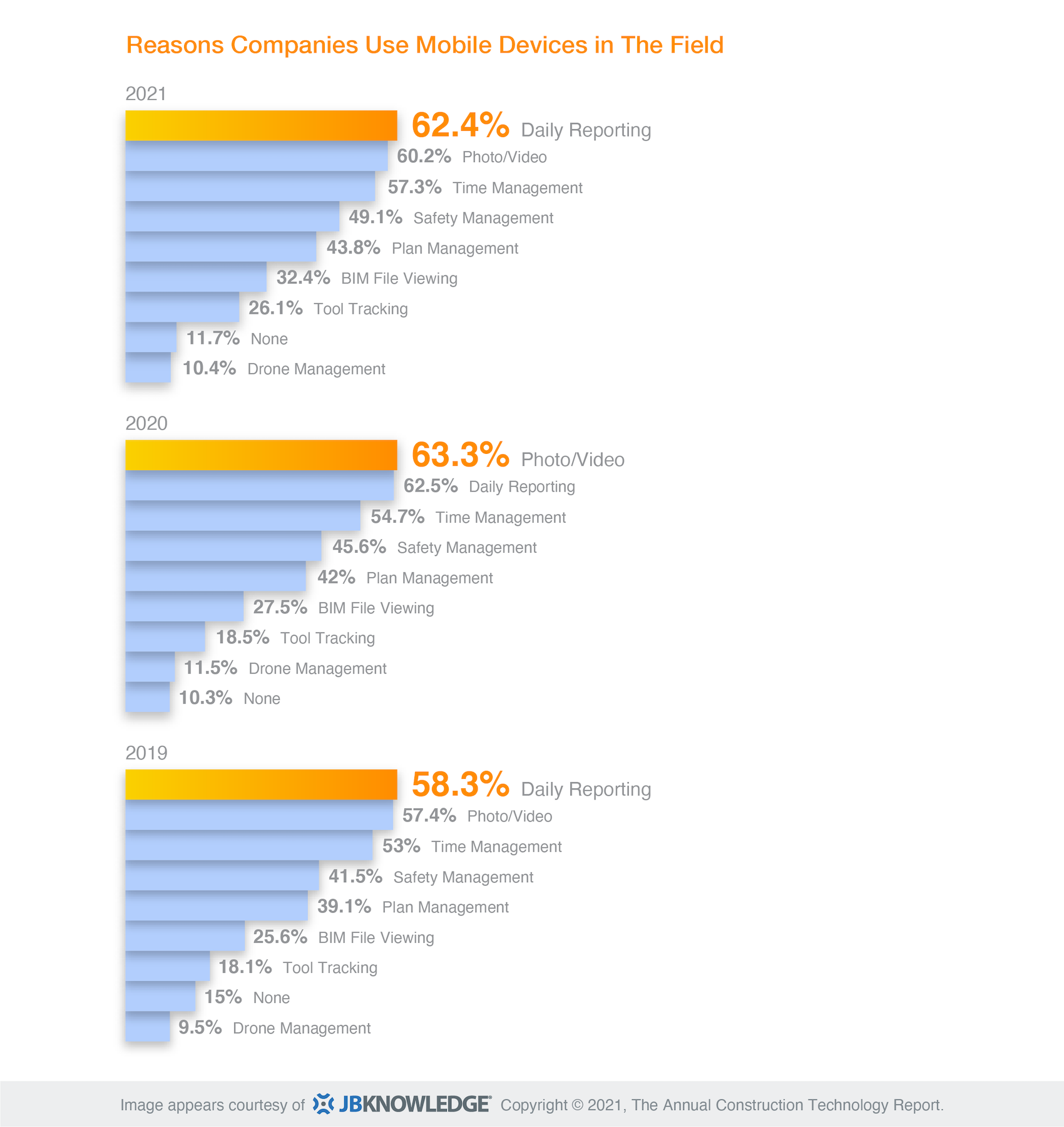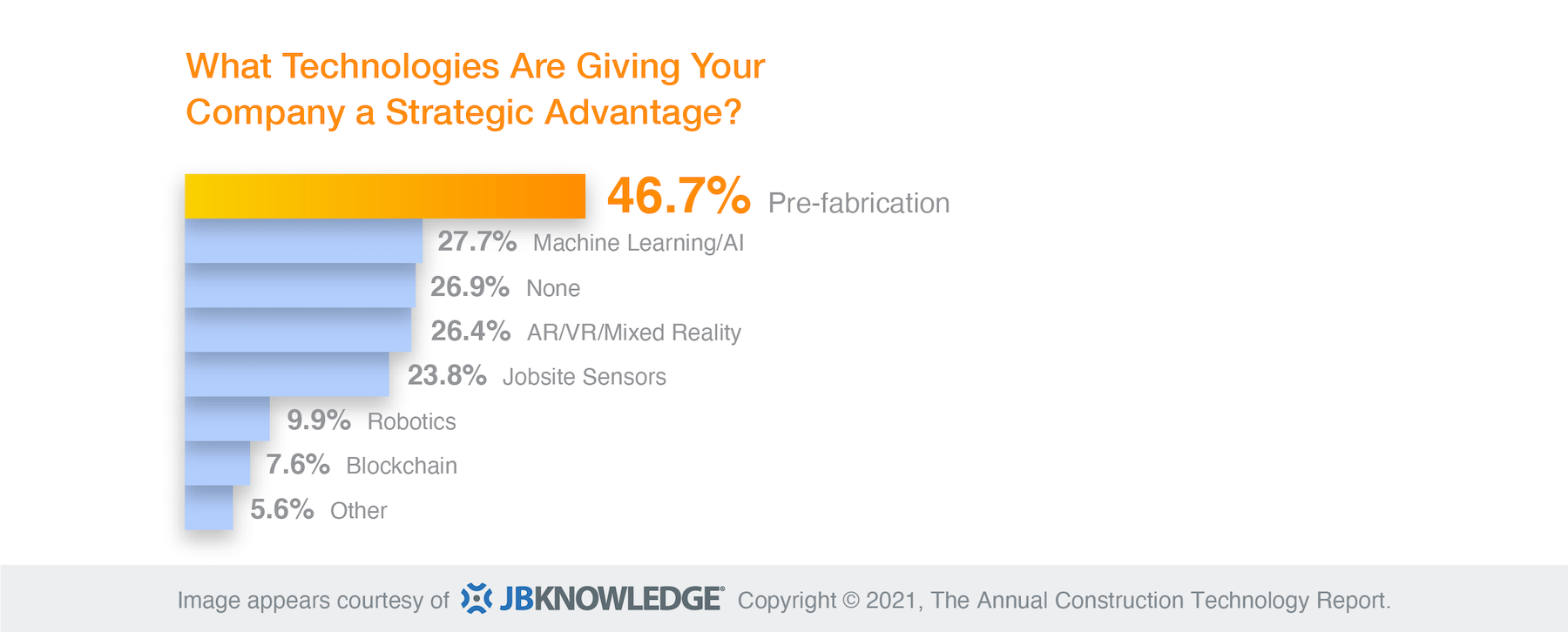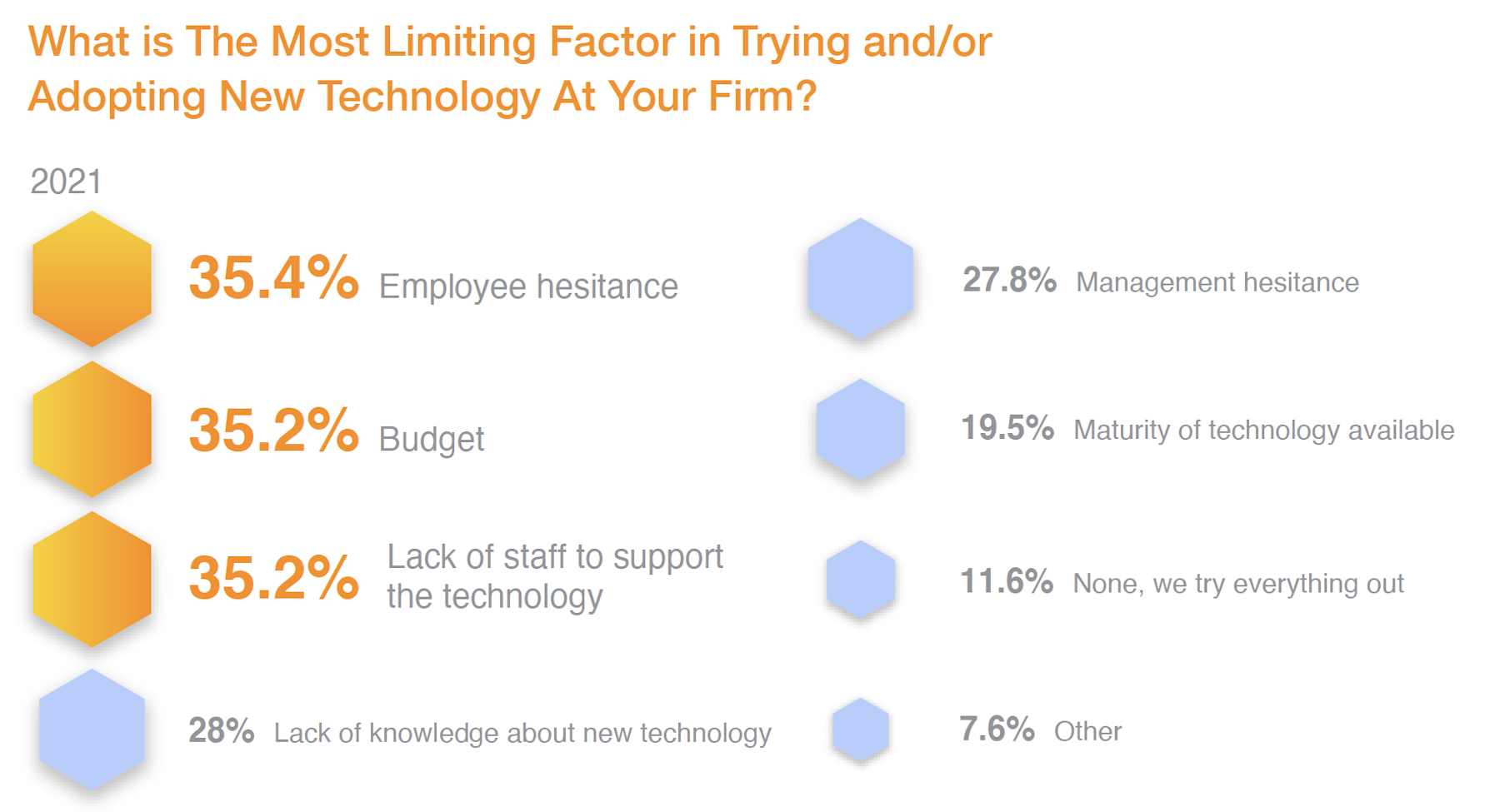In 2021, a record $4.5 billion were invested in Construction Technology startups, triple the amount in 2020, according Cemex Ventures. But there remains a disconnect between this outpouring for innovation and what’s actually being used in the field and back offices.
For example, less than half of contractor companies have departments dedicated to Information Technology, and even fewer don’t bill for IT expenditures. Over the past few years, construction companies have been reducing dedicated IT support and relying more on outsourcing some, if not all, of their IT functions.
Those are some of the findings that emerge from the 10th edition of JBKnowledge’s Annual Construction Technology Report, which was recently released. The report was produced in partnership with the Mechanical Contractors Association of America, the National Electrical Contractors Association, the Construction Financial Management Association, the Sheet Metal and Air Conditioning Contractors’ National Association, and the Construction Sciences Department of Texas A&M University.
JBKnowledge did not reveal the exact number of respondents to its survey except to tell BD+C that around 2,000 were from the construction industry in both field and administrative capacities. The survey was conducted in June and July 2021.
More than half of the total respondents to JBKnowleldge’s survey was between the ages of 42 and 61. Just over one-fifth (21 percent) was female, and the highest percentage of respondents (30 percent) was executives. Nearly three-quarters (73.8 percent) identified commercial building as their primary industry. While the survey received responses from 29 countries, 96.3 percent arrived from North America.
The report betrays an industry with too many companies that don’t prioritize IT. “Many construction companies fail to realize that an investment in IT will [lead to] greater profitability and increased ROI,” the report contends. “It’s no coincidence that construction companies are measuring on the lower-end of productivity as compared to other industries.”

While three-fifths of those polled say their companies have between one and five employees dedicated to IT on their payrolls, more than one-third spends less that 1 percent of annual sales on IT. “Construction spending on IT is behind the curve.”
MOBILE APP INTEGRATION A CHALLENGE
The report is not without its contradictions. Respondents were generally satisfied with the IT training and resources their companies provided them. While 43.4 percent says their companies have dedicated R&D employees, 56 percent doesn’t have dedicated R&D budgets. “The most important thing to remember about Research & Development is: If you make R&D a ‘spare time’ endeavor, you will only receive ‘spare time’ results,” the report cautions.
More than half of the respondents says their companies’ cybersecurity includes using mobile device management, two-factor authentication, and cyber liability insurance. (Twelve percent of those polled says their companies experienced a data breach in 2021, and another 6 percent answered “I don’t know” to the question about breaches.)

The top reason why respondents say they use mobile devices in the field is for daily reporting (62.4 percent), followed by photo/video capture (60.2 percent) and time management (57.3 percent) “Anyone who has been on the fence about whether a mobile app is necessary, the construction industry has spoken—mobile apps are key.” But technology integration remains a “big challenge” for many companies: more than half of all respondents still manually transfers data for apps without integrations. A surprising 15.3 percent of respondents doesn’t transfer data between apps at all, up from 11.8 percent in 2019.
Nearly all of those polled use smartphones for daily work purposes. But only around one-third says that their companies request that personal devices be secure and approved. (35.3 percent doesn’t use such personal devices at work.)
PREFAB A ‘COMPETITIVE ADVANTAGE’

Based on the survey’s responses, Procore is the favored app for managing plans, daily reporting, safety management, time management, and image capture; Bluebeam for viewing BIM files; DroneDeploy for controlling drones; and ToolWatch for tool tracking.
Workflows likely to rely on dedicated software include accounting/ERP (83 percent), estimating (60.7 percent), and project management (58.2 percent). However, more than three-fifths of those polled say they still use spreadsheets for estimating instead of software, and more than two-fifths use spreadsheets over software for project management.
The most popular software includes Sage for accounting/ERP (21.3 percent of respondents cited it), OnScreen Takeoff for takeoffs (37.6 percent), custom in-house software for estimating (17 percent), BuildingConnected for bid management (31.2 percent), Microsoft Project for scheduling (59.8 percent), Procore for project management (46.2 percent), and Consential for client relationship management (32.4 percent).
As for tech innovations, 36.6 percent of respondents says their companies use drones on jobsites (although that percentage was down from previous years). And nearly two fifths (38.6 percent) say their companies have built with prefabricated components in the previous 12 months. Nearly half of respondents sees prefab as a competitive advantage.
Conversely, a portion of contractors still isn’t sold on Building Information Modeling (BIM): 35 percent says their firms outsource it, and 27.8 percent says their firms don’t bid on projects that involve BIM or Virtual Design and Construction (VDC). “The good news is, for the first time in the past five years more respondents reported their company had a BIM department,” the report states.
Related Stories
| Aug 11, 2010
Pella introduces BIM models for windows and doors
Pella Corporation now offers three-dimensional (3D) window and door models for use in Building Information Modeling (BIM) projects by architects, designers, and others looking for aesthetically correct, easy-to-use, data-rich 3D drawings.
| Aug 11, 2010
High-profit design firms invest in in-house training
Forty-three percent of high-profit architecture, engineering, and environmental consulting firms have in-house training staff, according to a study by ZweigWhite. The 2008-2009 Successful Firm Survey reports that only 36% of firms overall have in-house training staff. In addition, 52% of high-profit firms use an online training system or service.
| Aug 11, 2010
Jacobs, HDR top BD+C's ranking of the nation's 100 largest institutional building design firms
A ranking of the Top 100 Institutional Design Firms based on Building Design+Construction's 2009 Giants 300 survey. For more Giants 300 rankings, visit http://www.BDCnetwork.com/Giants
| Aug 11, 2010
Walt Disney Family Museum planned in San Francisco
Construction is under way on a new museum dedicated to the man behind the Disney empire. Set to open this fall in San Francisco, the Walt Disney Family Museum will feature 10 galleries, starting with Disney's beginnings on a Missouri farm.
| Aug 11, 2010
Polshek Partnership unveils design for University of North Texas business building
New York-based architect Polshek Partnership today unveiled its design scheme for the $70 million Business Leadership Building at the University of North Texas in Denton. Designed to provide UNT’s 5,400-plus business majors the highest level of academic instruction and professional training, the 180,000-sf facility will include an open atrium, an internet café, and numerous study and tutoring rooms—all designed to help develop a spirit of collaboration and team-oriented focus.
| Aug 11, 2010
Callison, MulvannyG2 among nation's largest retail design firms, according to BD+C's Giants 300 report
A ranking of the Top 75 Retail Design Firms based on Building Design+Construction's 2009 Giants 300 survey. For more Giants 300 rankings, visit http://www.BDCnetwork.com/Giants
| Aug 11, 2010
ASHRAE releases free BIM introductory guide
A newly released guide from ASHRAE on building information models and building information modeling (BIM) serves as a resource for professionals considering BIM tools and applications for their businesses. According to "An Introduction to Building Information Modeling," BIM is “a digital representation of the physical and the functional characteristics of a facility.” Unlike 2D or 3D CAD, BIM software utilizes intelligent objects to create models.
| Aug 11, 2010
BIM research: New IPD document quantifies savings, shows obstacles
The American Institute of Architects and the AIA California Council have released the results of “Integrated Project Delivery: Case Studies,” a collection of six studies that showcases the process changes and efficiencies of completed building projects that utilized and implemented IPD. IPD is a construction project model in which owners, design professionals, and general contracto...







